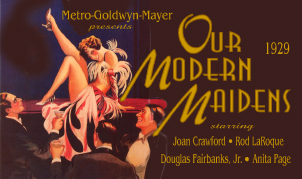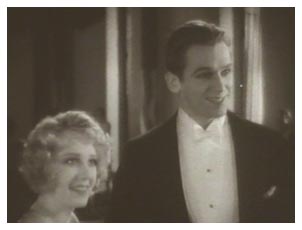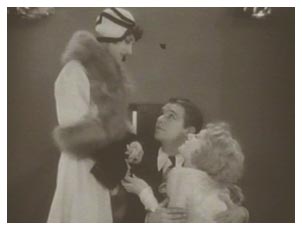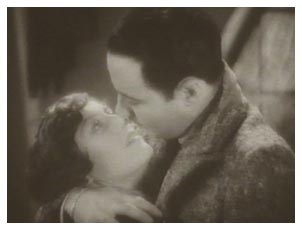

Distributed by Metro-Goldwyn-Mayer
Directed by Jack Conway
Cast: Joan Crawford (Billie Brown), Rod La Roque (Glenn Abbott), Douglas Fairbanks, Jr. (Gil Jordan), Anita Page (Kentucky), Edward Nugent (Reg), Josephine Dunn (Ginger), Albert Gran (B. Bickering Brown)
The synopsis comes from Lawrence J. Quirk's The Films of Joan Crawford (1968):
Billie Brown (Joan Crawford), daughter of B. Bickering Brown
(Albert Gran), a wealthy motor magnate, is in love with Gil (Douglas
Fairbanks, Jr.) and they plan to be  married
when Gil's diplomatic appointment is finalized. To hurry up the
marriage, Billie visits Abbott (Rod LaRocque), a diplomat with
political connections, and asks him to speed up Gil's appointment.
Billie and Abbott get to know each other, and soon they are in
love, but the feels duty-bound to marry Gil. Meanwhile, however,
Gil has come to know Kentucky (Anita Page), Billie's pert houseguest
from the hinterlands, and a deep attraction grows between them.
Soon after, they make love; later, Kentucky finds herself pregnant.
Gil, not knowing this and not realizing that Billie has also fallen
in love with someone else, decides that he must do his duty and
marry Billie, though he loves Kentucky. The wedding goes through
on schedule, but jus before Billie and Gil start out on their
honeymoon, Kentucky reveals to Billie that she and Gil love each
other and that she is pregnant. Billie leaves Gil and later goes
to Abbott in South America. Gil and Kentucky plan for the future
after an annulment of Gil's and Billie's marriage is obtained.
In the end, all are properly mated with the ones they truly love.
married
when Gil's diplomatic appointment is finalized. To hurry up the
marriage, Billie visits Abbott (Rod LaRocque), a diplomat with
political connections, and asks him to speed up Gil's appointment.
Billie and Abbott get to know each other, and soon they are in
love, but the feels duty-bound to marry Gil. Meanwhile, however,
Gil has come to know Kentucky (Anita Page), Billie's pert houseguest
from the hinterlands, and a deep attraction grows between them.
Soon after, they make love; later, Kentucky finds herself pregnant.
Gil, not knowing this and not realizing that Billie has also fallen
in love with someone else, decides that he must do his duty and
marry Billie, though he loves Kentucky. The wedding goes through
on schedule, but jus before Billie and Gil start out on their
honeymoon, Kentucky reveals to Billie that she and Gil love each
other and that she is pregnant. Billie leaves Gil and later goes
to Abbott in South America. Gil and Kentucky plan for the future
after an annulment of Gil's and Billie's marriage is obtained.
In the end, all are properly mated with the ones they truly love.
Yes, ridiculous. In excelsis at that. Our Modern Maidens isn't a sequel proper to the previous year's Our Dancing Daughters, a benchmark of Hollywood's depiction of the jazz age and also the film that made Crawford a star, as much as a cheerful market calculation. In his Joan Crawford: The Ultimate Star (1983), still the most insightful book-length overview of Crawford's long career, Alexander Walker notes that
As this is being written, Hollywood is locked into what could be called 'filming by numbers' or 'the sequels syndrome,' placing hope and huge budgets on the proposition that not only do people know what they like, but, even more, they like what they know and will continue to like it if given it often enough. This nowadays seems a product of terminal desperation; five [now eight] decades ago, it was a confident and buoyant trend.
So the elements from Daughters are in place: champagne, Packards, the indolent and unthinking narcissism of youth, parties in Act Deco environs, and wealth and possibility stretching into the empyrean. Crawford, Page, and Edward Nugent, holdovers from the previous film, are joined here by Douglas Fairbanks, Jr., scion of Hollywood royalty and Crawford's soon-to-be first husband.
 For the first 40-45 minutes, it
works. Most of the time Fairbanks, Jr., is merely pretty (to be
fair, his cardboard role doesn't coax from him anything like his
superb performance the year before as Garbo's alcoholic younger
brother in A Woman of Affairs); but when he's called upon
to do impersonations of John Barrymore, John Gilbert, and especially
his own father as Robin Hood, he's a riot. Director Jack Conway
keeps a move on and maintains a galloping sense of We've Got the
World on a String as Crawford and cohorts tinkle their glasses
and dance, helped in no small part by Cedric Gibbons' stylized
rendering of B. Bickering Brown's home, setting of the de rigueur
party and later wedding; it's luxe, absurd, and quite wonderful.
The photography of Oliver Marsh, beautifully judged and often
glowing with intimacy (in particular the lakeside love scenes
under moonlight), captures the shimmering last hurrah of the silents.
For the first 40-45 minutes, it
works. Most of the time Fairbanks, Jr., is merely pretty (to be
fair, his cardboard role doesn't coax from him anything like his
superb performance the year before as Garbo's alcoholic younger
brother in A Woman of Affairs); but when he's called upon
to do impersonations of John Barrymore, John Gilbert, and especially
his own father as Robin Hood, he's a riot. Director Jack Conway
keeps a move on and maintains a galloping sense of We've Got the
World on a String as Crawford and cohorts tinkle their glasses
and dance, helped in no small part by Cedric Gibbons' stylized
rendering of B. Bickering Brown's home, setting of the de rigueur
party and later wedding; it's luxe, absurd, and quite wonderful.
The photography of Oliver Marsh, beautifully judged and often
glowing with intimacy (in particular the lakeside love scenes
under moonlight), captures the shimmering last hurrah of the silents.
And then it all falls to pieces. Behind the MGM tinsel is prolonged, tiresome moralizing: Sex Has Consequences, so Page must sob, flail about, sob, shake, and sob some more. (Ever the refined English scribe, Walker discreetly but amusingly wishes that the Maidens scriptwriters had followed the lead of their Daughters cohorts and found a long staircase for Page to fall down.) Noble Sacrifice Is The Way to Go, so Crawford must lift her chin, slowly walk out of her own reception, and wind up in the arms of LaRoque, who has no chemistry with her, has no screen presence, and is altogether a roque (sorry). Doing the Right Thing makes for a contrived and dull resolution.
But Our Modern Maidens is worth seeing, very much so, for Crawford. She's a bit untutored, if you will, but the camera catches a radiance all her own, present through about 1933 and quite missing from her later imperious, often derided, incarnation as La Craw. The radiance may have been simple afterglow, for Crawford's autobiography, A Portrait of Joan (1962), offers a telling reminiscence about the response to Our Dancing Daughters: "[I discovered] that incredible thing, a public . . . From this moment on I had a sense of audience, warm living people who would care for me in direct proportion to the energy and talent I could give, a public to whom I owed a loyalty and from whom I've always received loyalty."
She's playing to that public here, sometimes in overdrive,
but with the flush and exhilaration of one who has been affirmed
at last. "Escape Artist," David Denby's thoughtful review
of Donald Spoto's Possessed: The Life of Joan Crawford in
the January 3, 2011, issue of The New Yorker, notes that
the early Crawford has "a fantastic vitality, a sheer  joy in moving and being watched. . . . she
is pleasure-loving and wild, yet candid and friendly, a straight
shooter who gets the guy."
joy in moving and being watched. . . . she
is pleasure-loving and wild, yet candid and friendly, a straight
shooter who gets the guy."
Performing for and maintaining the love of that public remained a central antidote to the poverty and abuse that Crawford had known early in life, requiring a sanctum wherein she could nurture that relationship. When Fairbanks, Jr., came to write his own memoir, My Salad Days, in 1988, he recalled that when he and Crawford went on a very belated and extended honeymoon to Europe in 1932, she stunned him with a confession near the end of the trip:
She hated it all! She put on a brave, well-trained smiling face, said the right words of gratitude, but she was only peripherally interested. She felt, she confessed, like a fish out of water, gasping for breath, longing for something familiar to cling to. She would have been, she said, just as content to read about these things-and, anyway, the pictures she'd seen seemed better than the real things! She was so frightened and felt so alien, that it was like a bad dream. All she wanted to do was get home as quickly as possible-home to the United States, home to California, home not to [their house] Cielito Lindo, but to the Culver City and MGM studios, home to the security of what she could recognize, home to her work. So home we went-ahead of schedule. She didn't return for years.
Sadly enough, that sense of security, like youth itself,
could be sustained only for so long before time's scourge chipped
away at her physicality and confidence, entwined sources of capital
from which she drew her performances. I can't watch any of her
pictures made after the excellent film noir Sudden Fear
(1952), and even the ones following her Academy Award-winning
performance in Mildred Pierce (1945) can be hard going.
Denby's analysis of the risible La Craw is spot on: "The
ravenous smile, the scything broad shoulders, the burdensome distress,
the important walk and complicated hair-she's too insistent, too
laborious and heavily armed . . . and she demand[s] that you capitulate
to her vision of herself." Late in life she admitted to journalist
Roy Newquist (Conversations with Joan Crawford, 1980) that
she had begun drinking heavily in the late 1930's upon reaching
a certain age and that her Academy Award brought a poignant revelation:
"The morning after, when I realized the award wasn't
a dream after all, I realized that Mildred Pierce really
rang down the curtain on 'my' Hollywood. . . . My professional
and personal worlds had changed so much. . . good friends were
dying or moving away. . . the public was restless about making
up its mind what it wanted to see . . . the studios were in bigger
and bigger trouble. No, my day, my long and golden and often glorious
day, had ended, and Mildred Pierce was sort of a bittersweet
celebration of the end." The  early
radiance by that point had hardened into grim, iron-jawed magnetism,
and as she descended into increasingly tawdry pictures in the
1950's and 1960's, she must have intuitively sensed what Robert
Frost had summed up years before:
early
radiance by that point had hardened into grim, iron-jawed magnetism,
and as she descended into increasingly tawdry pictures in the
1950's and 1960's, she must have intuitively sensed what Robert
Frost had summed up years before:
To return to Our Dancing Daughters and Our Modern Maidens, however, is to understand why MGM producer Harry Rapf picked her out of a New York chorus line and took a chance on her in 1925, to understand as well why Conrad Nagel introduces her in The Hollywood Revue of 1929 as "the personification of youth and beauty and joy and happiness." The line is hopelessly cheesy, but it's apt: F. Scott Fitzgerald thought her "The best example of the flapper . . . dancing deliciously, laughing a great deal with wide, hurt eyes. Young things with a talent for living." This archetype was the first of many for Crawford, and after more than eight decades, it remains enchanting: she's sweet and eager to please, with a heart-melting smile. (Just watch her when she's playing drums at the party and see if you don't capitulate happily.) She's in the right place as well. Denby thinks that she should have been at Warner Brothers from the beginning of her career, but one pauses there: she needed the prestige and glamour of MGM to shine with singular radiance and to stoke her competitive nature-pitted against Garbo, the Barrymore brothers, and Wallace Beery in Grand Hotel (1932), she walks away with the film.
If you've not seen Our Dancing Daughters, go with
that one first: though it too leans toward melodrama near the
end, it's overall a better constructed picture and of course remains
emblematic for its window into the hedonistic postwar sensibility
of privileged youth. But Our Modern Maidens captures Joan
Crawford in the golden moment when dreams had come true, when
she was a name above the title and in the first bloom of love
with both her audience and Fairbanks, Jr. The fantastic life force
with which she responded makes one think not of Frost this time,
but of William Blake: "Energy is eternal delight."
Copyright 2012 by Dean Thompson. All rights reserved